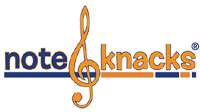Here is a lesson from my “Pushing the Limits” Collection ~ Lesson One 2.0
Although, rests aren’t discussed until Phase 3 of the Note Knacks Curriculum, children will write rests instead of notes when they trace their blocks in Phase 2. This is a perfect opportunity to point out the difference between rests and notes. When it happens, this is a wonderful lesson to teach.
Objective
- Students will practice using rests
- Students will use them in their compositions.
- Set of Note Knacks and the 4/4 Time Signature Frame
- Rhythm instruments and/or Orff instruments
- Poem: (words on top, rhythm on the bottom)
We are lit-tle Ic-i-cles / Melt-ing in the sun
Yel-low yel-low yel-low red/ Yel-low yel-low red rest
Can you see our ti-ny tear-drops / fal-ling one by one
Yel-low yel-low yel-low yel-low / Yel-low yel-low red rest
METHODS
- Have children talk about what the poem means, drawing attention to what happens to water in different temperatures & what teardrops signify.
- Discuss Rests: For every length of sound there is an equal length of silence. Show the red Note Knack block to point out that one side has a note on it and the other has a rest on it.
- Using the 4/4 Time Signature Frame, work out each line of the poem, leaving the rest beat blank in the Frame and asking the students to fill the missing piece. Highlight that all four notes in the measure need to be accounted for with either notes and/or rests.
- As they figure out the rhythm for each measure, write it on the board in conventional notation.
- Have the students choose instruments to play the whole rhythm.
- Play it a few times through
- For this class or the next ~ Use the poem as an A Section and create a TALA of 8 beats for a B Section.
- Demonstrate how to improvise an 8-bar rhythm utilizing rests.
- Have students take turns improvising rhythms for 8 bars utilizing rests. (It can be as simple as a steady beat with one rest included)
- Using Note Knacks and the 4/4 Time Signature Frame, divide students into groups and have them create a 2-4 bar rhythm that incorporates a rest. Be sure that each measure stays within the 4/4 Time Signature Frame.
- NOTE: I have made the mistake of having each group create 1 measure that includes a rest. When you put all of the measures together, there are too many rests. Since then, I have had kids create more measures, still with only one rest, so that the new concept doesn’t show up in every single measure, possibly one right after another. It is usually too challenging.
- Put all of the compositions on the magnetic board or in a pocket chart and have kids decide on the composition order for a B Section. (Play it through many times moving measures around until the kids hear one, they like. Ask the kids which measure to move where. You would be surprised at how thoughtful they can be in their answers!)
- Have class play A Section (the poem rhythm) then the B Section ~ and A again, if you would like!
Assessment
- Did the student understand the difference between a note and a rest?
- Did the student create a 4/4 pattern using a rest?
- Did the student play everything correctly?
Extra Possibilities
- This is a good way to incorporate Language Arts standards into the music room.
- This can be used with other poems
- Teach it in one class or over multiple classes


0 Comments